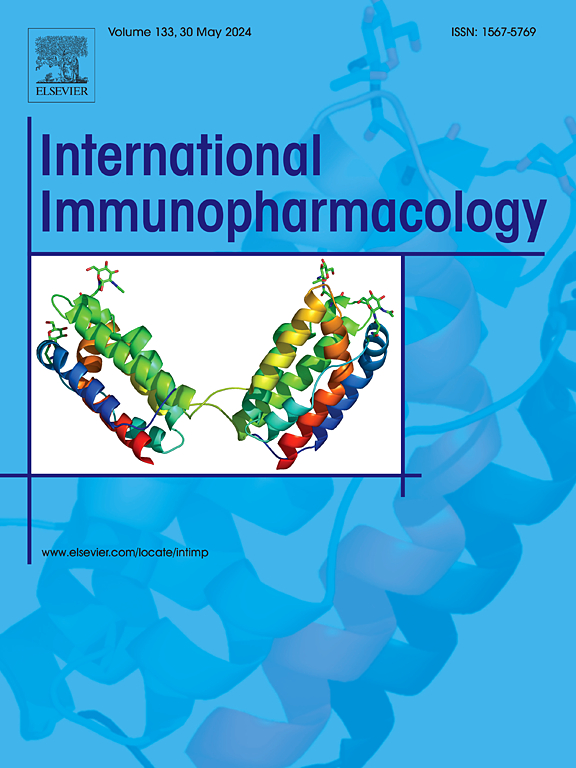自身免疫性疾病中PAMP和DAMP驱动NETosis激活的机制
IF 4.7
2区 医学
Q2 IMMUNOLOGY
引用次数: 0
摘要
中性粒细胞胞外陷阱(NET)的形成,通常被称为NETosis,是一种先天免疫反应,其中中性粒细胞释放嵌入抗菌蛋白的染色质结构来对抗病原体。虽然NETosis在宿主防御中起着关键作用,但失调的NETosis越来越多地与自身免疫性疾病的发病机制有关,包括系统性红斑狼疮、类风湿关节炎和抗磷脂综合征。这一过程的核心是病原体相关分子模式(PAMPs)和损伤相关分子模式(DAMPs),它们是NETosis的有力触发因素。PAMPs来源于微生物成分,而DAMPs则来自受损的宿主组织,它们与模式识别受体(PRRs)结合,激活细胞内信号级联,导致NET的形成。新出现的证据强调了NETosis在调节免疫反应中的双重作用:在促进微生物清除的同时,过度或长时间的NETosis会通过暴露自身抗原和使炎症持续而加剧自身免疫。这篇综述探讨了PAMP和damp驱动的NETosis的机制见解,它们在自身免疫病理生理学中的相互作用,以及它们作为缓解疾病进展的治疗靶点的潜力。本文章由计算机程序翻译,如有差异,请以英文原文为准。
Mechanistic insights into PAMP and DAMP driven activation of NETosis in autoimmune disorders
Neutrophil extracellular trap (NET) formation, commonly known as NETosis, is an innate immune response where neutrophils release chromatin structures embedded with antimicrobial proteins to combat pathogens. While NETosis plays a critical role in host defense, dysregulated NETosis is increasingly implicated in the pathogenesis of autoimmune disorders, including systemic lupus erythematosus, rheumatoid arthritis, and antiphospholipid syndrome. Central to this process are pathogen-associated molecular patterns (PAMPs) and damage-associated molecular patterns (DAMPs), which act as potent triggers for NETosis. PAMPs, derived from microbial components, and DAMPs, released from damaged host tissues, engage pattern recognition receptors (PRRs) to activate intracellular signaling cascades leading to NET formation. Emerging evidence highlights the dual role of NETosis in modulating immune responses: while it facilitates microbial clearance, excessive or prolonged NETosis exacerbates autoimmunity by exposing self-antigens and perpetuating inflammation. This review explores the mechanistic insights into PAMP- and DAMP-driven NETosis, their interplay in autoimmune pathophysiology, and their potential as therapeutic targets to mitigate disease progression.
求助全文
通过发布文献求助,成功后即可免费获取论文全文。
去求助
来源期刊
CiteScore
8.40
自引率
3.60%
发文量
935
审稿时长
53 days
期刊介绍:
International Immunopharmacology is the primary vehicle for the publication of original research papers pertinent to the overlapping areas of immunology, pharmacology, cytokine biology, immunotherapy, immunopathology and immunotoxicology. Review articles that encompass these subjects are also welcome.
The subject material appropriate for submission includes:
• Clinical studies employing immunotherapy of any type including the use of: bacterial and chemical agents; thymic hormones, interferon, lymphokines, etc., in transplantation and diseases such as cancer, immunodeficiency, chronic infection and allergic, inflammatory or autoimmune disorders.
• Studies on the mechanisms of action of these agents for specific parameters of immune competence as well as the overall clinical state.
• Pre-clinical animal studies and in vitro studies on mechanisms of action with immunopotentiators, immunomodulators, immunoadjuvants and other pharmacological agents active on cells participating in immune or allergic responses.
• Pharmacological compounds, microbial products and toxicological agents that affect the lymphoid system, and their mechanisms of action.
• Agents that activate genes or modify transcription and translation within the immune response.
• Substances activated, generated, or released through immunologic or related pathways that are pharmacologically active.
• Production, function and regulation of cytokines and their receptors.
• Classical pharmacological studies on the effects of chemokines and bioactive factors released during immunological reactions.

 求助内容:
求助内容: 应助结果提醒方式:
应助结果提醒方式:


